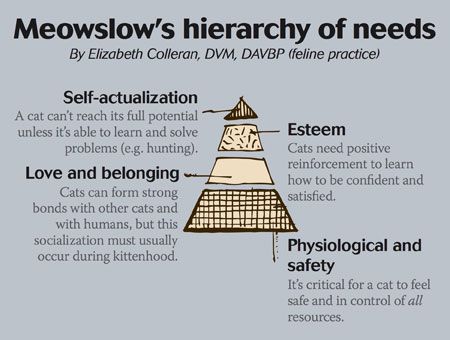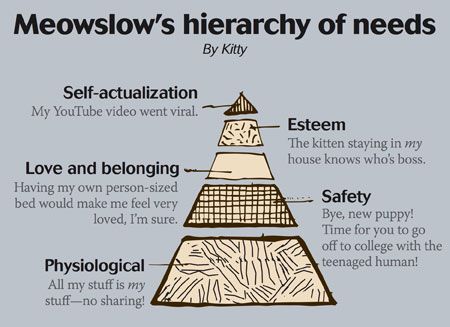Meowslows hierarchy of needs
Cats have needs beyond food and shelter. And the better you and your veterinary clients understand these needs, the closer the kitties in your clinic will come to reaching their full potential.

Maslow's hierarchy of needs for needs for kitties. (Shutterstock)

This article is part of a larger package that explores all aspects of pet enrichment. Click on the image above to read other articles in this package.If you've ever signed up for a semester of Psychology 101, you've probably sat through a lecture on Maslow's hierarchy of needs.
But if you need a refresher (or an introduction), it's a hiearchical pyramid that was intended to describe how people are motivated. According to Abraham Maslow, people are motivated to meet personal needs, and certain needs are more important than others. For example, people will pursue getting enough food and water before seeking feelings of accomplishment, though all are considered as needs by Maslow.
As you well know, cats are people too, so the structure of Maslow's hierarchy of needs still applies-with some slight tweaks:
Physiological and safety needs. These two go paw-in-paw in the cat world. Nothing is more important to them than their territory and the familiarity this brings, and it's critical for cats to know they can rest without fear of ambush. Ten thousand years of domestication hasn't changed their reliance on place-a place to hunt, mate, rear young, rest and be safe.
Sharing is not part of a cat's repertoire. Kitties are the ultimate control freaks. They like to have access to all the resources they feel they need-all day, every day-without competition. This includes food, water, toys, beds, hiding places, high lookout perches, litter boxes and scratching posts.
Love and belonging needs. Cats generally don't like cats they haven't known their whole lives. Those raised together from the time they are kittens (mainly littermates), can fully bond and demonstrate connected behaviors that indicate their friendship. Bonded cats willingly share resources and don't threaten one another. They approach with tails upright, rub against one another and settle down to rest in physical contact. While resting, these cats may groom one another.
Cats that are particularly friendly with one another will rub heads and cheeks and then continue to move past one another, torsos touching, and may end with the tails intertwining. During this time, their eyes will appear soft and unfocused, and they may close their eyes in a slow blink.
These relationships are mirrored in the behavior a cat will show when bonded to a human. Facial rubbing, sitting close to us or in our laps, grooming us-all are clear indicators of a loving relationship between a cat and a human. Most cats must be socialized with a variety of humans between 2 and 8 weeks of age in order to achieve this level of comfort with humans.
Esteem needs. Growing up in a low-risk environment, coupled with a genetic advantage, will help a cat feel confident in its world. Plenty of gentle handling in the first few months of life can turn a naturally bold cat into a highly social one. Cats are learning all the time, both good and bad. Teaching them with positive reinforcement how to tolerate novelty, how to feel as if they are in control of any situation and how to feel safe in an uncertain situation (the cat carrier, the veterinary visit) is key to their confidence and satisfaction.
Self-actualization needs. Problem solving is a significant part of a full and satisfying cat life. Hunting isn't easy. It takes time, dexterity, physical exertion, cognitive skill and acute sensory concentration. The second part of realizing a cat's full potential is learning. A great deal of learning occurs in hunting-one false move and prey is lost. Mice can disappear in and out of vegetation, rabbits can scoot down holes and birds can fly away if approached too quickly. Each type of prey presents a unique set of problems. Hunting is wonderfully pleasurable for cats-the reward center of the brain releases endorphins.
Most cat owners do pretty well with meeting a cat's physiological, safety, love and belonging, and esteem needs but stop short before reaching this final tier. The solution: Let's help owners satisfy our patients' self-actualization needs through environmental enrichment.

Kitty's needs are simple: unchecked power and internet fame.Kitty's purrspective
Need some concrete examples for this pyramid? We went straight to the source and asked Kitty. Here are her thoughts. (Note: May not be applicable to all felines. Each cat has its own purrticulars.)
Dr. Elizabeth Colleran is the owner and Hospital Director of two exclusively feline practices and is an ABVP Diplomate in Feline Practice. She participated in the 2013 Bayer Veterinary Care and Usage Study 3 – Feline Findings. Prior to veterinary school, she worked in Sales and Marketing Management for IBM where she worked with Fortune 500 companies to streamline internal networks. Her passions are her crazy husband, two equally crazy Burmese cats, bicycling and Indian cuisine.
Newsletter
From exam room tips to practice management insights, get trusted veterinary news delivered straight to your inbox—subscribe to dvm360.